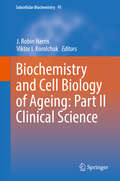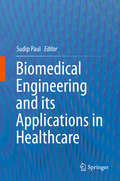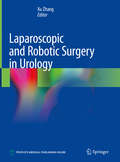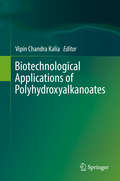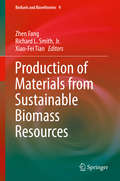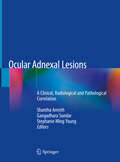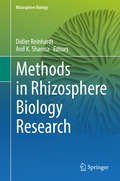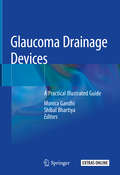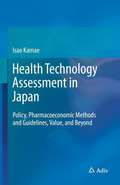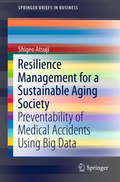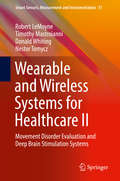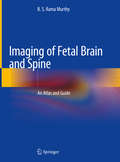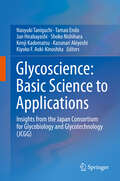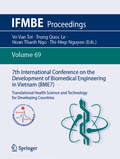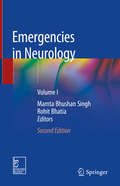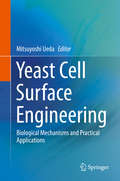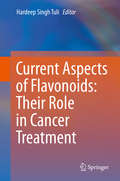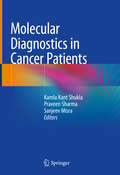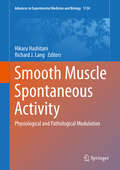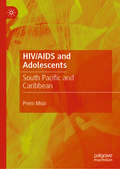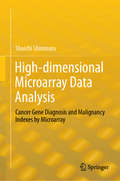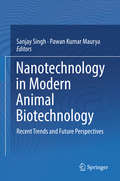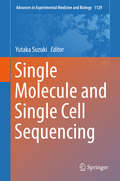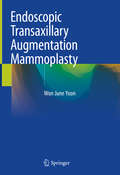- Table View
- List View
Biochemistry and Cell Biology of Ageing: Part II Clinical Science (Subcellular Biochemistry #91)
by J. Robin Harris Viktor I. KorolchukThis volume of the subcellular Biochemistry series will attempt to bridge the gap between the subcellular events that are related to aging as they were described in the first volume of this set of two books and the reality of aging as this is seen in clinical practice. All chapters will start from the biochemistry or cell biology, where the data is available and work up towards the understanding that we have of aging in the various areas that are related to the subject. Key focus points for this volume are nutrition, external factors and genetics on aging. There will also be chapters that will focus on various organs or tissues in which aging has been well studied, like the eyes, the muscles, the immune system and the bones. The aim of the book project and the book project that is published in concert with this volume is to bring the subcellular and clinical areas into closer contact.
Biomedical Engineering and its Applications in Healthcare
by Sudip PaulThis book illustrates the significance of biomedical engineering in modern healthcare systems. Biomedical engineering plays an important role in a range of areas, from diagnosis and analysis to treatment and recovery and has entered the public consciousness through the proliferation of implantable medical devices, such as pacemakers and artificial hips, as well as the more futuristic technologies such as stem cell engineering and 3-D printing of biological organs. Starting with an introduction to biomedical engineering, the book then discusses various tools and techniques for medical diagnostics and treatment and recent advances. It also provides comprehensive and integrated information on rehabilitation engineering, including the design of artificial body parts, and the underlying principles, and standards. It also presents a conceptual framework to clarify the relationship between ethical policies in medical practice and philosophical moral reasoning. Lastly, the book highlights a number of challenges associated with modern healthcare technologies.
Laparoscopic and Robotic Surgery in Urology
by Xu ZhangThis book is a practical guide to the laparoscopic and robotic surgery technique in urology. It includes 34 chapters in three sections, which are adrenal gland, kidney and ureter surgery, bladder and prostate surgery and lympadenectomy. This book covers all parts of laparoscopic and robotic urological surgery, including methods in patient selection, peri-operative management, step-by-step descriptions of specific techniques and complication avoidance. It is accompanied with over 800 illustrations and real-time capture figures. It also includes over 40 surgery videos with online access. Through the combination of texts, pictures and videos, it presents the surgical designing, surgical procedures and surgical techniques in panorama. This book is a good reference book for urologists who interested in these techniques.
Biotechnological Applications of Polyhydroxyalkanoates
by Vipin Chandra KaliaThis book presents the latest research on the uses of polyhydroxyalkanoates (PHA), introducing readers to these natural, biodegradable polyesters produced by microorganisms, their functions and applications. The individual chapters discuss the various potentials of these bioplastics, which offer an attractive alternative to non-biodegradable plastics. The book also describes the diverse medical and biomedical applications of PHAs, including their use as drug carriers, memory enhancers, and biocontrol agents, and examines their role in creating a more sustainable economy – which is the need of the hour.
Production of Materials from Sustainable Biomass Resources (Biofuels and Biorefineries #9)
by Zhen Fang Richard L. Smith Jr Xiao-Fei TianThis book presents a collection of studies on state-of-art techniques developed specifically for lignocellulose component derivation, and for the production of functional materials, composite polymers, carbonaceous biocatalysts, and pellets from lignocellulosic biomass, with an emphasis on using sustainable chemistry and engineering to develop innovative materials and fuels for practical application. Technological strategies for the physical processing or biological conversion of biomass for material production are also presented. All chapters were contributed by respected experts in the field from around the globe, providing a broad range of perspectives on cutting-edge applications.The book offers an ideal reference guide for academic researchers and industrial engineers in the fields of natural renewable materials, biorefinery of lignocellulose, biofuels and environmental engineering. It can also be used as a comprehensive reference source for university students in chemical engineering, material science and environmental engineering.
Ocular Adnexal Lesions: A Clinical, Radiological and Pathological Correlation
by Shantha Amrith Gangadhara Sundar Stephanie Ming YoungThis comprehensive book focuses on eyelid, lacrimal and orbital lesions, covering a wide variety of common and rare diseases and correlating their clinical, radiological and pathological aspects. It presents a large number of illustrative cases, with a discussion of the clinical history, examination, the imaging and pathology findings, differential diagnosis and management along with a take home message for each. Further, it offers clear guidance on the diagnosis and management of orbital and adnexal lesions. This book is a valuable learning tool for residents and trainee fellows in ophthalmology, as well as for trainees in radiology and pathology. It is also relevant to young ophthalmic plastic and reconstructive surgeons, practicing ophthalmologists, radiologists, and pathologists.
Methods in Rhizosphere Biology Research (Rhizosphere Biology)
by Didier Reinhardt Anil K. SharmaThis book compiles various methodologies used in understanding interactions within the rhizosphere. An in-depth understanding of the rhizosphere is essential to developing successful strategies for future sustainable agriculture. The book summarizes methods and techniques used to study the mechanisms involved in mutualistic symbioses and pathogenic interactions of plants with various microbial organisms including fungi, bacteria, and oomycetes. Each chapter discusses different methodologies used in rhizosphere biology, while also providing real-world experimental data and trouble-shooting tips. Interested researchers will also find a wealth of literature references for further research. As the first comprehensive manual and compilation of methods and techniques used in rhizosphere biology, the book represents an essential resource for all researchers who are newcomers to soil microbiology experimentation.
Glaucoma Drainage Devices: A Practical Illustrated Guide
by Monica Gandhi Shibal BhartiyaThis book offers a comprehensive guide to the use of glaucoma drainage devices (GDDs) in various clinical settings, and covers aspects ranging from the basics to managing complications. The aim of this work is to provide readers with a practical go-to desktop book to assist in and enhance their surgical competence with glaucoma drainage devices. Starting with the history of GDDs, it addresses various devices, their models and modifications, and highlights their advantages and disadvantages through numerous illustrations. The indications for the drainage devices are discussed in detail, using patient cases with photographs. The book describes the techniques for all devices in detail, which are explained further in accompanyin videos. After covering the basic techniques, the book provides extensive notes on modifications that may be required in various case presentations such as congenital glaucoma, post-penetrating keratoplasty with extensive peripheral synechiae, and procedure through pars plans etc. Complications and their management are subsequently addressed. The book is an essential guide to help surgeons match patients to the most suitable device, and to support patients from preparation through post-operative care. Primarily intended for glaucoma surgeons, it offers a valuable resource for fellows in training, and all who have an interest in glaucoma surgery.
Health Technology Assessment in Japan: Policy, Pharmacoeconomic Methods and Guidelines, Value, and Beyond
by Isao KamaeRepresenting the first book on the topic, this work offers the reader an introduction to the Japanese systems for health technology assessment (HTA) officially introduced by the Ministry of Health, Labour and Welfare (MHLW) in 2016. Policy and guidelines are discussed, with the relevant methods and conditions of cost-effectiveness analysis explained alongside. Numerous instructive examples and exercises, ranging from basic to advanced, impart valuable knowledge and insight on the quantitative methods for economic evaluation, which will appeal to both beginners and experts.This guidebook is authored by Japan’s foremost expert in HTA and pharmacoeconomics, with a view to strengthening the reader’s expertise in value-based healthcare and decision-making. The methods presented are essential to informing regulatory, local and patient decisions; as such, the book is equally recommended to industry and government, as well as academia, and anyone with an interest in Japanese HTA.
Resilience Management for a Sustainable Aging Society: Preventability of Medical Accidents Using Big Data (SpringerBriefs in Business)
by Shigeo AtsujiThis book utilizes big data to undertake a cluster analysis of medical accidents. Highlighting shared worldwide accident patterns, it represents a first step toward reducing the incidence of accidents through kaizen innovation driven by information and communications technology. This initiative comes against a background where medical accidents are currently the third largest cause of death after heart attack and cancer, making accident prevention an urgent concern. With the objective of preventing these accidents, which negatively impact numerous different stakeholders, and based on interdisciplinary research, the book examines (1) the application of data mining to identify shared accident patterns; (2) proposals for system improvement and organizational innovation aimed at risk and resilience in crisis management; and (3) the use of a global platform to achieve sustainability in the Internet of Medicine (IoM).
Wearable and Wireless Systems for Healthcare II: Movement Disorder Evaluation and Deep Brain Stimulation Systems (Smart Sensors, Measurement and Instrumentation #31)
by Robert LeMoyne Timothy Mastroianni Donald Whiting Nestor TomyczThis book provides a far-sighted perspective on the role of wearable and wireless systems for movement disorder evaluation, such as Parkinson’s disease and Essential tremor. These observations are brought together in the application of quantified feedback for deep brain stimulation systems using the wireless accelerometer and gyroscope of a smartphone to determine tuning efficacy. The perspective of the book ranges from the pioneering application of these devices, such as the smartphone, for quantifying Parkinson’s disease and Essential tremor characteristics, to the current state of the art. Dr. LeMoyne has published multiple first-of-their-kind applications using smartphones to quantify movement disorder, with associated extrapolation to portable media devices.
Imaging of Fetal Brain and Spine: An Atlas and Guide
by B. S. Rama MurthyThis book systematically covers the anatomy and pathology of the fetal brain and spine. It features a veritable treasure trove of ultrasound images illustrating every common finding, as well as rare lesions that are encountered in clinical practice. Wherever possible, it also includes 3D ultrasound and fetal MRI correlations.
Glycoscience: Insights from the Japan Consortium for Glycobiology and Glycotechnology (JCGG)
by Naoyuki Taniguchi Tamao Endo Jun Hirabayashi Shoko Nishihara Kenji Kadomatsu Kazunari Akiyoshi Kiyoko F. Aoki-KinoshitaThis book presents the state of the art in glycoscience and proposes a road map for the coming decade, focusing on the potential of glycoscience research to shed light on important basic science issues and give rise to exciting new applications, especially in the field of diagnosis and therapeutics. Individual sections offer in-depth coverage of various topics relating to glycans and biopharmaceuticals, glycans in medical science and medicine, glycan technologies, glycans in food and nutrients, and glycan-related materials and their uses. In addition, the book presents an exemplary training course on glycomics and highlights educational and analytical web resources, and also includes glossaries and boxes summarizing key facts to ensure ease of understanding for non-expert readers and students. Written by more than 150 active participants in the Japan Consortium for Glycobiology and Glycotechnology (JCGG), whose goal is to promote the development of interdisciplinary glycoscience and establish a global network in the field, it is a valuable resource for students, postdocs, and researchers in the life sciences as well as for stakeholders and professionals in government, funding agencies and industry.
7th International Conference on the Development of Biomedical Engineering in Vietnam: Translational Health Science and Technology for Developing Countries (IFMBE Proceedings #69)
by Vo Van Toi Trung Quoc Le Hoan Thanh Ngo Thi-Hiep NguyenThis volume presents the proceedings of the 7th International Conference on the Development of Biomedical Engineering in Vietnam which was held from June 27-29, 2018 in Ho Chi Minh City. The volume reflects the progress of Biomedical Engineering and discusses problems and solutions. It aims to identify new challenges, and shaping future directions for research in biomedical engineering fields including medical instrumentation, bioinformatics, biomechanics, medical imaging, drug delivery therapy, regenerative medicine and entrepreneurship in medical devices.
Emergencies in Neurology: Volume I
by Mamta Bhushan Singh Rohit BhatiaThis is the second edition (in two volumes) of a well-received book that reflects current practices in the management of neurological emergencies. It was written bearing in mind the needs of first-contact physicians, who may be neurology trainees, neurology consultants, or interns. Special attention has been paid to various aspects of managing patients at the emergency department, from taking a good clinical history, to completing a quick and focused clinical examination, to investigating and commencing treatment. Neurological emergencies are unique in that they appear abruptly, generally follow a volatile course, and require a prompt yet balanced response. The management of neurological emergencies has been a major challenge in the past, and today, early and aggressive approaches are generally recommended. Exploring these and other aspects, the book offers a valuable asset for all practitioners seeking answers to the questions that inevitably arise while attempting to manage such critical situations.
Yeast Cell Surface Engineering: Biological Mechanisms and Practical Applications
by Mitsuyoshi UedaThis book provides a detailed and up-to-date overview of all aspects of yeast cell surface engineering, including fundamental principles, practical strategies for the construction of engineered yeasts, as well as medical and industrial applications. The technique makes it possible to add eukaryotic modifications to the surface-displayed proteins/peptides, which is of significant value in basic and applied research. Generally referred to as an arming (molecular display) technology, it allows yeast to be used as a whole-cell biocatalyst for a range of purposes, including bio-energy production, pollutant removal, recovery of rare metal ions, and preparation of functional cells, all of which are comprehensively covered in the book. Among the medical applications discussed are in vitro antibody preparation and the production of oral vaccines. In addition, it presents the latest advances in protein engineering and high-throughput screening for directed evolution of enzymes. The book enables graduate students and researchers to gain a deeper, comprehensive understanding of the technology, and offers further inspiration for researchers and industrial experts in this rapidly evolving field.
Current Aspects of Flavonoids: Their Role in Cancer Treatment
by Hardeep Singh TuliThe book comprehensively introduces readers to various aspects of flavonoids, a category of natural metabolites that exhibits various pharmacological effects. It discusses their chemistry, absorption and metabolism, mechanisms of action and toxicology as well as future perspectives for clinical applications, and also provides detailed insights into their anti-cancer properties, since flavonoids are known to modulate tumor-associated intracellular as well as extracellular signaling pathways. The book also highlights the current research on the health effects of selected flavonoids, and their various roles in cancer prevention and treatment. Lastly, the book elucidates nanotechnology-mediated tools to enhance the bioavailability and solubility of flavonoids to improve their bioactivity and pharmacokinetic parameters.
Molecular Diagnostics in Cancer Patients
by Kamla Kant Shukla Praveen Sharma Sanjeev MisraThis book aims to bring together a broad variety of examples of the role of pharmacogenomics in current drug development, uncovering dynamic concentration-dependent drug responses on biological systems to understand pharmacodynamics responses in human cancer where genetic lesions serve as tumor markers and provide a basis for cancer diagnosis. The book describes methods and protocols applied in molecular diagnostics. It offers pathologists and researchers providing molecular diagnostic services an array of the most recent and readily accessible reference to compare methods and techniques. Highlights include the molecular diagnosis of genetic aberrations by quantitative polymerase reaction (qPCR), sequence-specific oligonucleotide arrays, next-generation sequencing (NGS), CGH arrays-and methodologies directed at the detection of epigenetic events, high-throughput nucleic acid and protein arrays, direct sequencing and FISH-based methodologies, currently used in the diagnosis of solid tumors. The book also includes an innovative line of treatment in relation to the molecular prognosis, diagnosis and pharmacogenomics in the actual practice of clinical findings at molecular levels. The book covers the applications of numerous genetic testing methodologies; in approximately the chronological order of discovery and high-throughput diagnosis using advanced genomic approaches to identify such genes, in the search for novel drug targets and/or key determinants of drug reactions. It also promotes a wider understanding of molecular diagnostics among physicians, medical students, and scientists in academics, industry and corporate world.
Smooth Muscle Spontaneous Activity: Physiological and Pathological Modulation (Advances in Experimental Medicine and Biology #1124)
by Hikaru Hashitani Richard J. LangThis book presents the commonality and heterogeneity of the mechanisms underlying smooth muscle spontaneous activity in various smooth muscle organs and in addition discusses their malfunctions in disease and their potential as novel therapeutic targets. To facilitate understanding, the volume is divided into five parts and covers 16 organs: airways, gastrointestinal tract (phasic muscle, tonic muscle), renal pelvis, ureter, urinary bladder, urethra, corporal tissue, prostate, uterus, oviducts, seminal vesicle, artery, vein, microvasculature, and lymphatic vessels. This structure will help readers to comprehend the most up-to-date information on the similarities and differences in the contractile mechanisms driving various smooth muscles as well as their potential manipulations in particular visceral organ pathologies. The vast advancements in gene, electrical recording, and imaging technologies in this field are also discussed, with review of past achievements and consideration of likely future developments. This book will be of worldwide interest to clinicians, students, and researchers alike.
HIV/AIDS and Adolescents: South Pacific and Caribbean
by Prem MisirThis book addresses the relationship between high school students’ HIV and AIDS knowledge and their stigma-related attitudes/perceptions of people living with HIV (PLHIV) in the Caribbean and South Pacific, with a view to designing effective stigma-reduction combined intervention programs. Presenting an international cross-sectional study using a purposive sample of high school students from Fiji (South Pacific), Vanuatu (South Pacific), Guyana, and Antigua & Barbuda (Caribbean) to assess HIV and AIDS knowledge and stigma-related attitudes by gender, age, religion, race/ethnicity, and socioeconomic status, the book shows how stigmatizing attitudes and beliefs negatively impact interventions to prevent and treat HIV and AIDS.
High-dimensional Microarray Data Analysis: Cancer Gene Diagnosis and Malignancy Indexes by Microarray
by Shuichi ShinmuraThis book shows how to decompose high-dimensional microarrays into small subspaces (Small Matryoshkas, SMs), statistically analyze them, and perform cancer gene diagnosis. The information is useful for genetic experts, anyone who analyzes genetic data, and students to use as practical textbooks.Discriminant analysis is the best approach for microarray consisting of normal and cancer classes. Microarrays are linearly separable data (LSD, Fact 3). However, because most linear discriminant function (LDF) cannot discriminate LSD theoretically and error rates are high, no one had discovered Fact 3 until now. Hard-margin SVM (H-SVM) and Revised IP-OLDF (RIP) can find Fact3 easily. LSD has the Matryoshka structure and is easily decomposed into many SMs (Fact 4). Because all SMs are small samples and LSD, statistical methods analyze SMs easily. However, useful results cannot be obtained. On the other hand, H-SVM and RIP can discriminate two classes in SM entirely. RatioSV is the ratio of SV distance and discriminant range. The maximum RatioSVs of six microarrays is over 11.67%. This fact shows that SV separates two classes by window width (11.67%). Such easy discrimination has been unresolved since 1970. The reason is revealed by facts presented here, so this book can be read and enjoyed like a mystery novel. Many studies point out that it is difficult to separate signal and noise in a high-dimensional gene space. However, the definition of the signal is not clear. Convincing evidence is presented that LSD is a signal. Statistical analysis of the genes contained in the SM cannot provide useful information, but it shows that the discriminant score (DS) discriminated by RIP or H-SVM is easily LSD. For example, the Alon microarray has 2,000 genes which can be divided into 66 SMs. If 66 DSs are used as variables, the result is a 66-dimensional data. These signal data can be analyzed to find malignancy indicators by principal component analysis and cluster analysis.
Nanotechnology in Modern Animal Biotechnology: Recent Trends and Future Perspectives
by Sanjay Singh Pawan Kumar MauryaThe book introduces the basic concepts of nanotechnology and the various technologies to characterize nanomaterials. It also covers the nanostructural features of mammalian cells/tissues and related nanomechanical properties. In addition, the book comprehensively describes the current state-of-the-art and future perspectives of nanotechnology in biosensors. It also discusses the potential of nanotechnology for delivering the diverse cancer therapeutics and illustrates its limitation due to the potential toxicity associated with oxidative stress. It also highlights the ethical issues and translational aspects related to nanotechnology. Finally, it summarizes the applications of nanotechnology in animal biotechnology, the recent perspectives and future challenges of nanomedicines. The content of the book are beneficial for the undergraduate, postgraduate and doctoral students as well the professionals working in the area of nanotechnology and nanomedicines.
Target Organ Toxicology in Caenorhabditis elegans
by Dayong WangThis book introduces readers to intestinal and epidermal barriers, and to toxicity induction of environmental toxicants or stresses in the intestine, epidermis, neurons, muscle, and reproductive organs in Caenorhabditis elegans. In addition, it discusses the protective responses of various organs and nematodes’ avoidance behaviour with regard to environmental toxicants or stresses. The intestinal, epidermal, neuronal, and germline signalling pathways required for the regulation of toxicity of environmental toxicants or stresses are also introduced and discussed. As a classic model animal with well-described genetic and developmental backgrounds, the nematode Caenorhabditis elegans has been successfully and widely used in both toxicity assessments and toxicological studies on various environmental toxicants and stresses. Once exposure to certain environmental toxicants has occurred, the toxicants can enter into the primary targeted organs (such as intestinal cells), and even be translocated into secondary targeted organs (such as reproductive organs and neurons). Based on related available data, this book provides a systematic understanding of target organ toxicology in C. elegans.
Single Molecule and Single Cell Sequencing (Advances in Experimental Medicine and Biology #1129)
by Yutaka SuzukiThis book presents an overview of the recent technologies in single molecule and single cell sequencing. These sequencing technologies are revolutionizing the way of the genomic studies and the understanding of complex biological systems. The PacBio sequencer has enabled extremely long-read sequencing and the MinION sequencer has made the sequencing possible in developing countries. New developments and technologies are constantly emerging, which will further expand sequencing applications. In parallel, single cell sequencing technologies are rapidly becoming a popular platform. This volume presents not only an updated overview of these technologies, but also of the related developments in bioinformatics. Without powerful bioinformatics software, where rapid progress is taking place, these new technologies will not realize their full potential. All the contributors to this volume have been involved in the development of these technologies and software and have also made significant progress on their applications. This book is intended to be of interest to a wide audience ranging from genome researchers to basic molecular biologists and clinicians.
Endoscopic Transaxillary Augmentation Mammoplasty
by Won June YoonThis book presents state of the art information on all aspects of endoscopic transaxillary augmentation mammoplasty with the aim of sharing the insights gained by the author during the performance of more than 2500 endoscopic breast augmentation procedures. With the aid of high-quality figures, the reader is guided through each step of the preoperative design and surgery, including when using a dual plane type II or III approach. Helpful information is also provided on anatomy, choice of implant, the endoscopy system and instruments, potential complications, and revision augmentation mammoplasty.Endoscopic transaxillary breast augmentation has been gaining in popularity owing to the various advantages that it offers, namely small incisions, enhanced visibility, and improved accuracy and predictability of breast enlargement. This book is exceptional in covering every facet of the procedure and related issues and in documenting best practice on the basis of a wealth of experience. It will equip those embarking on such surgery with essential knowledge and assist them in negotiating the learning curve.
